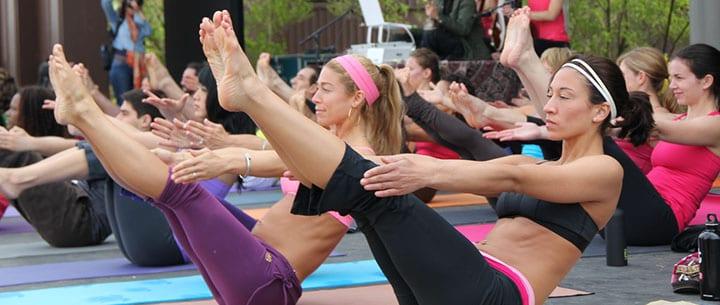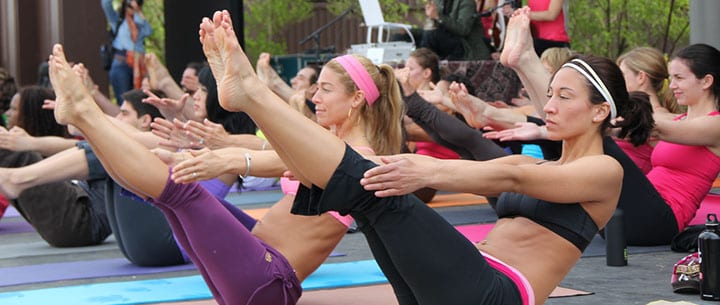Yoga for beginners doesn’t need to be nerve-wracking! Find out how to prepare for your first class and what to expect in this guest post by San Diego teacher Tiffany V...
Perhaps you’ve heard everyone talking about all the benefits of yoga and how great they feel after doing it, and are interested in seeing what it’s all about–but as a beginner, you’re nervous. You may be concerned that you’re not flexible enough, that you’ll embarrass yourself, or that other students will be able to do things you can’t. Relax. Yoga is not a competition. Rather than being intimidated by a yoga for beginners class, enter with excitement, and feel comforted knowing that yogis are generally very kind, non-judgmental, and supportive of one another.
- Private sessions offer you one-on-one instruction with the teacher there to observe and adjust you in each pose to ensure you are in proper alignment, whereas in group classes the attention you receive may be minimal as the teacher has a lot more students to focus on.
- Private sessions move at your pace, and are focused on your own body, personal goals, and individual intentions, rather than the general practice offered in group classes. This allows for a customized practice just for you to fuel the benefits you are seeking.
- Private classes are often offered in the comfort of your own home, which can save you drive time and hassle. Usually the only difference is having access to a large mirror to check your alignment (which all studios will have). A mirror can be beneficial, however, practicing without one allows you to feel out the poses in your body from the inside out rather than focusing so much on what they look like.
- Group classes are great if you are seeking a community to be a part of. A studio that resonates with you can be great for making new friends and connecting with like-minded people that support and inspire one another.
Private Instruction
Prepare Your Space
Find a place in your home that is comfortable for you and inspires you. At minimum you will need enough space for a yoga mat (72” x 24”) and a few feet around it for the instructor to walk around you. It is not completely necessary to have a mat if you have a carpeted area or rug accessible to practice on.
If you have a child/children or a dog, make sure they’re preoccupied so you can concentrate and practice peacefully without worry.
Have Your Equipment Ready
Wear comfortable activewear that won’t interfere with your movement. A formfitting shirt and pants that stay put on your body are best to avoid having to adjust your clothing. This will allow you to easily transition and settle into each pose without a lot of fuss. Also, have a towel and water handy.
Share Your Goals
Your instructor will typically contact you before your first session to learn about your interests and goals to prepare a class just for you. Take this opportunity to share as much as you can about yourself and what you’re looking to get out of your practice. It is also a great idea to share any injuries you may have or had. The more your instructor knows, the better. This will help him or her prepare a practice specifically for you, which will lead to better results.
The Studio Experience
Come Prepared
Same with the at-home sessions, wear comfortable activewear that won’t interfere with your movement–a formfitting shirt and pants that stay put on your body are best. Bring a yoga mat, water, and an extra hand towel to wipe sweat. If you are taking a heated class, a large towel that will cover your whole mat is helpful to keep you from slipping when you sweat.
When You Arrive
You can expect to fill out a customer profile and sign a waiver before practicing. This is a great opportunity to introduce yourself and let them know that it is your first time taking a class, as well as if you have any injuries that they need to be aware of. Typically whoever is checking you in will ask you a few questions too, and give you an introduction to their studio to fill you in on anything you may need to know before class starts.
Inside the Studio
Yoga etiquette calls for a quite environment with no talking to create a calm meditative space for students before class. Use this quiet time to clear your mind and settle into the space before you begin.
When deciding where to place your mat, consider the view of the teacher’s mat. They will usually have one set up front and center. You will want to have a clear view of the instructor to ensure you can easily see for proper alignment. Other students can act as demo of the poses as well. However, take into consideration that their alignment might not be correct or look like yours, especially if it is a beginner yoga class, since all bodies are different. So it is important to listen to the teacher’s cues and go where it feels right in your body.
During Class (Private & Studio)
At the beginning of class you will be instructed to begin ujjayi breathing: the breath of yoga. You can expect the teacher to cue each breath you take as a way to match it with the movement and allow you to fully experience each pose. Embrace the breath; it is ultimately there to serve you. It will bring in energy, strength, and focus to help soothe you when a pose may seem tough to hold. The slow, steady breath tells your body that you are calm and keeps your heart rate down.
You will move through a sequence of poses, ranging from sitting to standing to lying on your back. Each is designed with a particular intention, such as improving balance, restoring energy, or strengthening your body. The class will end in a final resting posture where you relax and receive the benefits of the practice.
The teacher will walk around class and offer hands-on adjustments to help get you into proper alignment or ease you deeper into poses. There will usually be a time for you to opt out if you prefer not to be touched. However, adjustments from the teacher can be very helpful in finding your proper alignment, so it is recommended to take advantage of them, especially as a beginner.
Use of props (blocks and straps) is also encouraged for new students; blocks bring the ground closer to you and are used for support, and straps can add extra length where you may need for reach. Make use of these props. They are not a crutch, they are there to assist.
Finally, yoga is usually taught using a combination of English and Sanskrit (the language of yoga). Typically, a teacher will share the Sanskrit pose name following the English name so you can associate it with that pose later in your practice. Here are a few popular Sanskrit words to be familiar with:
- Chaturanga dandasana – the high-to-low plank transition in a vinyasa class
- Savasana – corpse pose; the final resting posture where the benefits of the practice are received
- Namaste* – a greeting or farewell that means “the divine in me honors the divine in you, and with that shared divinity, we are one”
*At the end of class the teacher will bow and say “Namaste,” and then you repeat it back
Go For It
Some studios and instructors offer free classes or weeks for new students to try them out. Check around and take advantage of this if it is available. This offers you the opportunity to explore what each has to offer before deciding which studio or instructor resonates with you.
Beginning a yoga practice is an amazing gift to give yourself. The journey lends itself to so many wonderful physical, mental, and spiritual benefits. Embrace it with an open mind and heart. Before you know it, you will be the one telling all your friends about the amazing things that yoga has done for you.
Namaste
 Tiffany V. teaches meditation, reiki, and yoga in San Diego, CA. She completing the 200-hour RYT training at CorePower Yoga. Learn more about Tiffany here!
Tiffany V. teaches meditation, reiki, and yoga in San Diego, CA. She completing the 200-hour RYT training at CorePower Yoga. Learn more about Tiffany here!
 Photo by daveynin
Photo by daveynin
Suzy S.

